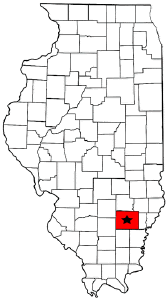
Brad Dye
Move to Fairfield, Illinois
January 2005

There is something hard to explain that was pulling me back to Fairfield, Illinois. I had moved around so much in the USA and fifty-some other countries that I was starting to feel disconnected. Coming back home has been very good for me. The landscape is soothing to my eyes and the way people talk sounds good to my ears. In my head at least, everything here is as it is supposed to be, and I somehow fit into the grand scheme of things. So many things here are familiar, the sound of the train going through town, the sound of the wind blowing through the trees, the mourning doves cooing, and even the smell in the air.
The easy-to-explain part is the re-establishment of old relationships with friends and relatives. The other night, while eating at a restaurant with my aunt and uncle, I saw the first "girl" that I ever fell in love with. She sat behind me at school in the fourth grade. I went over to her table and said hello to her and her husband. It felt good.
My aunt and uncle (my mother's brother—Don Hanks and his wife Nancy Brockett Hanks) are very special people who I have been close to all of my life. It is great to be able to spend time with them. They have two daughters (Linda Hanks Headley and Susan Hanks). One is a nurse and the other is a schoolteacher. We are friends as well as cousins.
I went to the local barbershop. The barber at the first chair who cut my hair is a first cousin on my father's side. As I walked in he said, "hello cousin Brad." The lady barber at the second chair was his daughter, and the barber at the third chair is married to another relative and I have known him all my life. This is good—very good. Everywhere I go, I run into cousins and other relatives. I see people in the grocery store that I went to grade school with.
I went to the local newspaper—The Wayne County Press—and bought a special issue of the paper from the week before that I wanted to read. It is called "The Pink Press" because it is printed on pink pager and it comes out once a year containing lots of letters from people who have moved away. Then I decided to go ahead and subscribe for home delivery. The lady at the desk handed me back my dollar. After discovering that a minimum subscription was one year and that I didn't have that much cash in my pocket, the lady said that they would just send me a bill. Later that afternoon, I found that day's new issue on my front porch. Now this all may seen to be "normal" activity to some people, but I was amazed. Several of these things would never happen in a big city. I used to deliver that newspaper on my bicycle—fifty years ago.
People here walk right up to me and want to know who I am. I tell them my name and that my family homesteaded here in Wayne County about one hundred and fifty-four years ago. They came down the Ohio River on a raft to Shawneetown and eventually settled between Geff and Cisne. I belong here. There is something comforting about that. I don't know if I will stay here for the rest of my life or not, but I am certainly enjoying it for now. As I drive around the county memories flood my head—some good and some bad, but since many of the memories were long forgotten it is like reliving the experiences for a moment. I am looking forward to my 45th high school class reunion this fall.
Brad Dye is a Fairfield native. He lived here from birth (1942) until his first year in high school, when his family moved to Lincoln, Illinois.
Brad is a wireless data consultant and the editor of an online newsletter that is read by about 2,000 people in nearly 50 countries. He is a member of the American Mensa Society, and he is on the board of directors of the European Mobile Messaging Association. He is also a current or former member of the Institute of the Electrical and Electronics Engineers (IEEE), the Quarter Century Wireless Association, the Radio Club of America, and the American Radio Relay League. Brad's Internet web site is: www.BradDye.com.
Fairfield, Illinois
 Fairfield is a city located in Wayne County, Illinois. As of the 2000 census,
the city had a total population of 5,421. It is the county seat of Wayne County.
Fairfield is a city located in Wayne County, Illinois. As of the 2000 census,
the city had a total population of 5,421. It is the county seat of Wayne County.
Geography
Fairfield
is located at 38°22'49" North, 88°21'57" West
(38.380390, -88.365818)1.
According to the United States Census Bureau, the city has a total area of 9.5 km² (3.7 mi²). 9.4 km² (3.6 mi²) of it is land and 0.1 km² (0.04 mi²) of it is water. The total area is 0.82% water.
Demographics
As
of the census of 2000, there are 5,421 people, 2,495 households, and 1,494
families residing in the city. The population density is 578.2/km² (1,499.0/mi²).
There are 2,727 housing units at an average density of 290.9/km² (754.0/mi²).
The racial makeup of the city is 98.40% White, 0.09% African American, 0.26%
Native American, 0.63% Asian, 0.02% Pacific Islander, 0.06% from other races,
and 0.55% from two or more races. 0.42% of the population are Hispanic or Latino
of any race.
There are 2,495 households out of which 24.8% have children under the age of 18 living with them, 46.4% are married couples living together, 10.8% have a female householder with no husband present, and 40.1% are non-families. 37.0% of all households are made up of individuals and 21.3% have someone living alone who is 65 years of age or older. The average household size is 2.11 and the average family size is 2.74.
In the city the population is spread out with 20.5% under the age of 18, 8.0% from 18 to 24, 24.1% from 25 to 44, 22.4% from 45 to 64, and 24.9% who are 65 years of age or older. The median age is 43 years. For every 100 females there are 82.1 males. For every 100 females age 18 and over, there are 77.6 males.
The median income for a household in the city is $25,797, and the median income for a family is $36,278. Males have a median income of $28,866 versus $19,985 for females. The per capita income for the city is $16,791. 13.1% of the population and 8.5% of families are below the poverty line. Out of the total population, 16.7% of those under the age of 18 and 9.6% of those 65 and older are living below the poverty line.
Source: Wikipedia, the free encyclopedia.